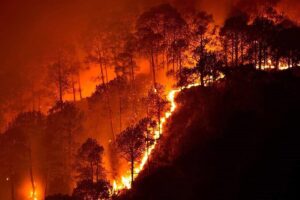2024 shattered global temperature records and with it came a surge in natural disasters across the United States. From blazing wildfires in California to catastrophic floods in North Carolina, the link between climate change and intensifying disasters is no longer hypothetical, it’s painfully real. According to the latest IPCC report, the frequency and scale of extreme weather events have already exceeded previous predictions. Even if greenhouse gas emissions are curtailed now, disaster risks are locked in due to existing warming.

Climate Change: A Growing Disaster Engine
Over the past year, America has experienced the brutal reality of climate-driven disasters. These aren’t isolated events; they are interconnected crises, fueled by rising global temperatures, erratic rainfall patterns, extreme droughts, and warming oceans. What once were seasonal concerns have now become constant threats.
The IPCC’s updated adaptation report confirms that disasters are already outpacing previous climate models. And since further warming is inevitable even in best-case emission scenarios the need to rethink disaster management is more urgent than ever.

Wildfires: From Natural Process to Unnatural Disaster
Wildfires have always been a part of some ecosystems. But now, they’re burning bigger, longer, and hotter. The new fire season spans more months, and fires are often ignited not by nature, but by human activity.
Climate change intensifies this by creating drier landscapes, more lightning strikes, and excessive vegetation growth that turns into flammable fuel. The U.S. has spent billions fighting fires, yet losses continue to mount.
Solutions?
Prescribed burns, stronger land-use planning, fire-resistant infrastructure and reduced emissions are essential. Rebuilding should be both green and resilient, incorporating climate-smart materials and environmentally sound practices.
Floods
When Water Becomes a Weapon
Floods affect more people globally than any other disaster. By 2050, their financial toll is projected to grow by $11 billion. Increasing rainfall, urban expansion into floodplains, and poor infrastructure are compounding the crisis.
Traditional “hard engineering” methods dams and concrete barriers can’t keep up and sometimes make things worse.
Hurricanes: Stronger Storms from Warmer Waters
Hurricanes, typhoons and cyclones are more dangerous now, thanks to hotter oceans and rising sea levels. Their intensity, duration and destructive potential have surged.
Nature can offer a shield. Mangroves, dunes, marshes, and coral reefs naturally dampen wave energy and reduce storm surge impacts. Yet many of these ecosystems are degraded or destroyed by human activity.
Post-hurricane reconstruction must be climate-informed. Using native, drought-tolerant species and sustainable land use plans can help ecosystems and communities recover together.
Tornadoes: Local Storms, Global Warning Signs
While mostly affecting the U.S., tornadoes are increasingly intense due to climate induced thunderstorm shifts. They strike fast and hard, with little warning especially threatening for vulnerable housing or areas with weak building codes.
Stronger construction standards, like wind resistant materials and accessible tornado shelters can save lives. Equally important is ensuring disaster response reaches everyone, especially those historically left behind.
The Inequality Factor
Disasters Hit Harder in Vulnerable Communities Whether it’s fires, floods, hurricanes, or tornadoes, the impact is never equal. Indigenous communities, people of color, and low-income groups bear the brunt living in more dangerous zones, in weaker housing, and with fewer resources for recovery.
After disasters, these communities face slower, tougher recoveries. For example, Black neighborhoods were the most devastated by Hurricane Katrina’s flooding. Similar trends exist with tornadoes, where poor zoning and inadequate shelter lead to deadly outcomes.
Inclusive disaster planning is not a luxury it’s a necessity. Policies must prioritize racial and social equity, from funding to infrastructure to emergency aid.
Compound Threats: One Disaster Fuels Another
Disasters don’t happen in silos. A drought can dry out forests, leading to wildfires. Fires destroy vegetation, which weakens soil. Then heavy rain triggers landslides and floods creating a vicious climate domino effect.
That’s why multi hazard planning is critical. Emergency systems must account for overlapping disasters not just single-event scenarios.
Conclusion
The Clock Is Ticking
Climate change has transformed the nature of natural disasters. We can no longer afford to act surprised by wildfires in spring, flash floods in suburbs, or storms that span entire states. The time to adapt is now. The tools are in our hands. And the solutions lie in science, equity, and nature.
Written by Vaishali Verma
